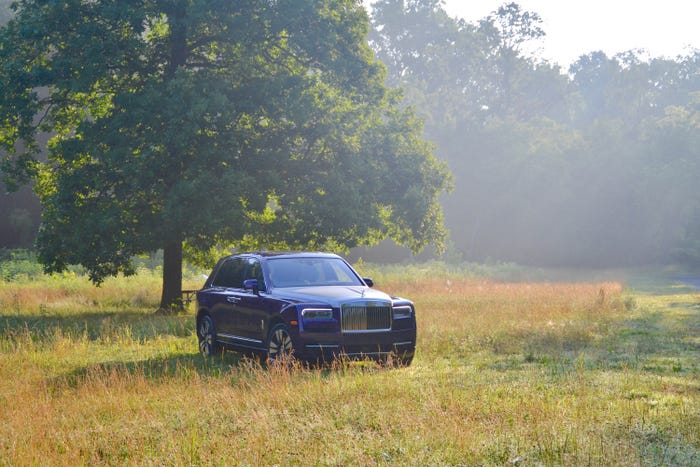The Cullinan is the first Rolls-Royce SUV, but it provides all the comforts expected of any vehicle behind The Spirit of Ecstasy hood ornament.

2020 Rolls-Royce CullinanDan Carney
When Rolls-Royce introduced the Cullinan SUV, those people who hadn’t yet reconciled themselves to the new reality that SUVs are cars now expressed dismay. But few buyers these days distinguish between cars and SUVs, other than by preferring to buy the tall, wagon-bodied vehicles over the traditional three-box (hood, cabin, trunk) sedans.
The Cullinan retains all of the signature Rolls-Royce pomp and circumstance; there’s a monstrously powerful engine beneath the hood, the rear doors are hinged at the back and contain umbrellas to protect against the weather typical of the car’s home country, and the Spirit of Ecstasy hood ornament leads the way from atop the Cullinan’s grille. As a quick aside for explanation, “Cullinan” was the name of the huge rough diamond from which the British Crown Jewels were cut.
We had the good fortune to spend a couple of days with the big Rolls luxury box and have been able to identify some attributes that exploit its body style, along with other technical features that underscore the Cullinan’s faithfulness to Rolls’ opulence.
Our test car listed for $426,700, with a base price of $330,000. It was finished in a two-tone paint job featuring Twilight Purple as the polarizing primary hue at a cost of $11,900, while the contrasting silver on the hood (or bonnet, in Rolls-Royce jargon) added another $7,725.
The posh Selby Grey perforated leather upholstery is accented with Tailored Purple piping ($4,150) and stitching ($2,150) corresponding to the paint on the outside. While the Rolls-Royce Phantom sedan is noted for its fiber optic starfield headliner as a cabin highlight, the Cullinan instead beckons its passengers to observe real stars through its enormous panoramic sunroof that yawns open over the occupants’ heads.
Having custom paint colors that cost as much as a very reasonable compact car is a clue that the Cullinan operates on a different plane from mere transportation. Indeed, Rolls-Royce tells us that its customers don’t weigh another car as the potential alternative to buying their Rolls-Royce. Instead, they’re considering a boat, plane, or vacation home as alternative uses for the purchase price.

Additionally, customers are looking for the opportunity to have experiences rather than to acquire objects, so if this acquired object can facilitate experiences, then that is a mark in its favor. To do that, the Cullinan routes power from its 571-horsepower, 627 lb.-ft, 6.75-liter twin-turbocharged V12 to all four wheels, letting the Cullinan go places no Rolls-Royce sedan would dare tread.
In combination with an actively adjustable air shock suspension system, the Cullinan’s computer-controlled, driver-selectable all-wheel drive can cope with sand, snow, gravel, wet grass, and mud with the unruffled aplomb for which Rolls-Royce vehicles are justifiably renowned. The company refers to this characteristic as the “Magic Carpet Ride,” and the Cullinan delivers it in places that were unthinkable until now.
During the media debut drive of the Cullinan, Rolls-Royce provided the opportunity for us to cane the Cullinan along a snow-dusted fire road, and it responded superbly, even on its comfort-centric road tires. This was no hard-core off-roading, but the ability to claw its way along a gravel two-track with an icy layer on top with the utmost poise was truly confidence-inspiring.

What is hardcore off-roading is the Rebelle Rally. The company loaned a stock Cullinan, again including the factory-standard tires, to automotive journalist Emme Hall, and she finished that punishing race in it with ease.
Driving fast off the road would be a challenging task in a Rolls-Royce before now because the Magic Carpet Ride exacted a penalty in handling and steering response. When your car is piloted by a chauffeur, such matters are secondary to ride comfort, after all.
But the Cullinan is a vehicle that owners are expected to drive themselves most of the time, and it is tuned to provide more feel and feedback through the steering wheel so the driver can tell what is happening beneath all the open-pore wood and opulent leather. The active air suspension lets it do this without compromising the ride, which is a minor miracle.
Despite the truncated test opportunity, we were fortunate to have experienced the vehicle’s animal recognition alert in the head-up display. This is a technology that is shared with Rolls-Royce’s BMW corporate cousins, so it is not necessary to spend the better part of a half-million dollars to benefit from it, but it does remain the domain of high-end brands.

Pedestrian warning and identification systems appeared first, providing drives an alert when a relatively easy-to-identify biped appears in the field of view of the car’s infrared night vision camera. But animals are a tougher challenge, and the Cullinan aced it when we passed a deer standing on the shoulder of a rural highway.
As the driver, we saw the yellow deer-shaped alert projected onto the windshield and slowed, but never saw the deer. The front seat passenger, however, did spot the deer in the dark on the roadside as the Cullinan passed. Considering that people are killed striking deer every year, this is a great incremental improvement to driving safety and it was exciting to experience the Wildlife and Pedestrian Warning system at work.
While Wildlife and Pedestrian Warning is not unique to the Cullinan’s SUV body style, a variety of “activity modules” are available for the Cullinan. These are inserts that can be installed into the Cullinan’s cargo bay to provide specialized functions for owners. Click through the slide show for a look at those and other details of the Cullinan.
About the Author(s)
You May Also Like





